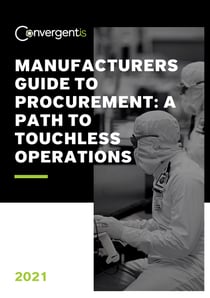In a world plagued with uncertainties, carrying out supply chain management for manufacturers in a way that is profitable has proved to be the ultimate challenge. This is largely due to the increase in supply chain complexity across all industries, and especially manufacturing.
In this blog post, we will go into detail on the major complexities plaguing supply chain management in 2021 and how businesses can adopt infrastructure that can help them to respond accordingly.
1. Raw Material Scarcity Across All Product Lines
With the recent challenges of Covid-19, many companies are struggling to meet manufacturing demand due to the limited availability of many parts and materials. This is largely attributed to the initial shock of the pandemic, which influenced economies (and enterprises) to stockpile raw materials to keep up with the recovering demand, and in turn, fueling additional shortages. Material scarcity should not be taken lightly; in fact, according to RetailNext, 56% of businesses needed to renegotiate contracts as a result of severe shortages and going out-of-stock on several key items, 28% attempted to find alternate sourcing options and 28% underwent shortages and out-of-stocks as a result of the Covid-19 pandemic.
Since inputs have been scarce, manufacturers must continue to plan accordingly and keep an inventory balance that accommodates downtime. This largely contrasts with the manufacturers advocating zero-inventory production as a cost-saving initiative, which requires an efficient global supply chain management system rather than one that stockpiles.
The strategy: Unfortunately, shortages in raw materials are the result of a lack of business planning. Experienced supply chain executives will typically qualify more than one supplier to fill the need of a commodity. Although this process can be lengthy, taking the time to do this ahead of time will help businesses be more agile so they can switch among them as unforeseen circumstances arise.
2. Milestones to Manage
When customer bases and product lines expand, your supply chain will expand as well. While the number of steps per order will stay the same, the number of orders will increase, and managing delivery times become of even greater importance. For these reasons, getting granular requires additional effort to ensure all exceptions such as a shipping delay, or a lost delivery are managed in real-time.
The strategy: Managing more milestones will require a cohesive dashboard that highlights exceptions in the supply chain process. Escalations that require quick decision-making may be lost if several spot solutions are being used.
3. Increased Freight Prices
The worldwide lockdown has increased the number of consumer sales and raw materials required, resulting in a direct decrease in the availability of shipping containers. This demand is significantly more than anticipated and was only met with insufficient shipping capacity and an unprecedented shortage of empty and available containers. As the natural supply and demand would state, scarcity in products led to a jump in pricing and an added cost to manufacturers.
Above all else, China is known as one of the largest manufacturers in the world and is largely dependent on European Countries and North America to purchase their products, requiring many shipping containers for overseas transactions. Container availability has shrunk since Covid, which in combination with the already high shipping container price, has proved to be a real challenge for businesses.
The strategy: Increased freight prices are the result of factors external to a business’ control. Therefore, businesses can mitigate these added expenses by conducting complete cost comparisons across suppliers (including freight costs and lead times). With an easier look into both sides, sourcing teams can identify the most cost-effective solution.
4. Too Much Data
Businesses now have more data available than ever before. Unfortunately, too much data can be overwhelming without the ability to interpret it. Data, when presented properly, can be used in forecasting and real-time decision-making about suppliers and navigating complex networks. As more parties become involved in the digital supply chain, spot solutions may be incorporated to “patch up” gaps in data as they arise leading to the data being scattered across a smorgasbord of applications.
The strategy: Rather than managing a series of spot solutions, businesses should look for opportunities to consolidate data. Many new procurement solutions can integrate data stored both on and off a business’ ERP system, so teams can view data in a cohesive dashboard. Some solutions may support automatic reporting that distills data for easy interpretation.
5. Volatility
Volatility is an ongoing concern in supply chain management. Political circumstances, new tariffs, and other concerns involving trade routes might occur in waves that will have a ripple effect across the rest of your purchasing and supply chain management systems. If they are not dealt with as they arise, these concerns might lead to delays, backlogs, and other bottlenecks in the current system.
The strategy: The key to dealing with supply chain volatility is a quick response time. As issues arise, teams must be equipped with properly organized data to develop contingency plans and make quick pivots in response to world situations. The reverse is also true that in lower tariffs or other positive advancements, businesses require a solution that showcases data across the end-to-end process, so businesses may determine how best to take advantage of the situation.
Procurement Solutions to Tackle Complexity
These challenges in supply chain management are not going away anytime soon. While many of the causes for complexity come from external sources, several can be attributed to the way your business works. Some teams may have custom processes that are only applicable to certain suppliers, while others are bogged down with divisions in your organization that complicate the approval process. Regardless of the concern, as new challenges arise, businesses must already have the necessary procurement infrastructure to make quick decisions.
To learn more about what this means for manufacturers, we encourage you to check out a full breakdown in our complete procurement guide to touchless operations. Here, we outline how these concerns can be addressed within the SAP framework.


